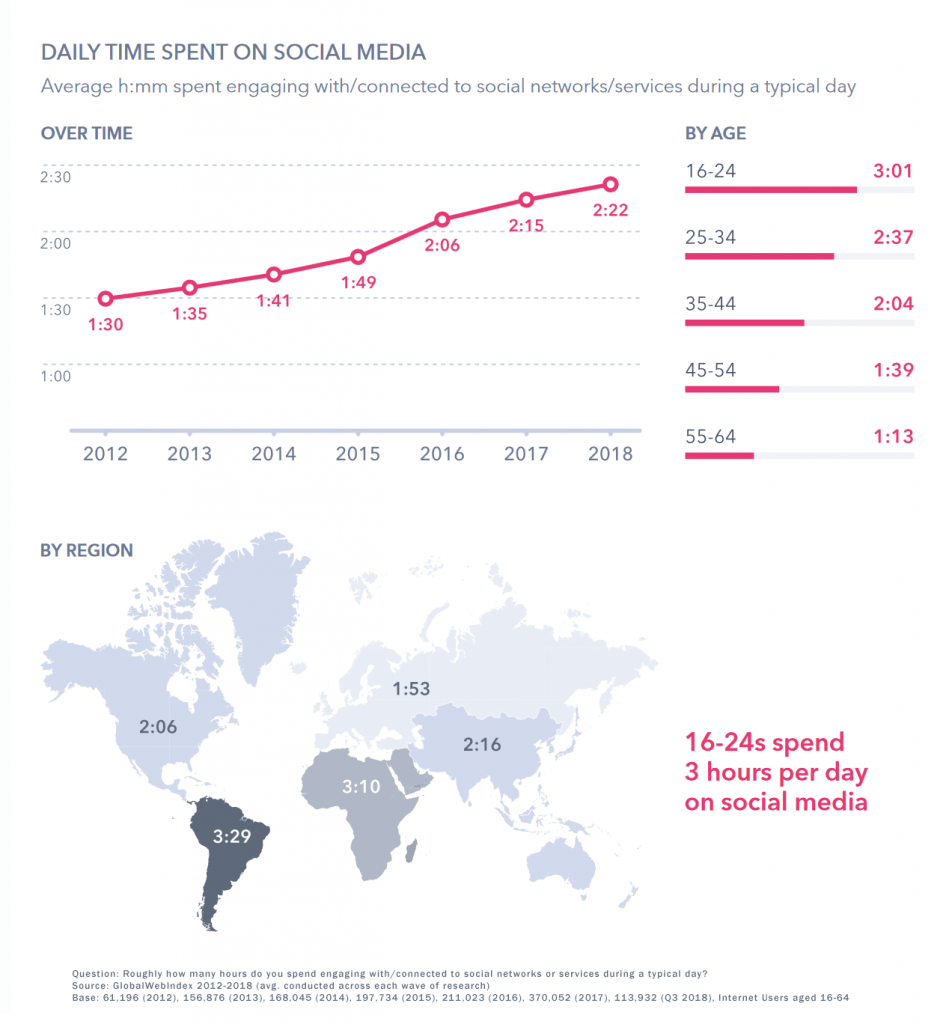According to Social Media Today, people will spend more time over their lifetime using social media than they will eating, or socializing using other methods.

A slightly more recent study from the Global Web Index (shared via Digital Information World) shows that the trend is not about to reverse any time soon. Year after year, we tend an increasing amount of time on social media.
It’s vital then, that businesses tap into the power of social media and use it to reach their audience. This creates an excellent potential for agencies working in digital marketing, PR and communications.
Your agency may already be offering various marketing and communication services – but your clients will often want to get everything they need in the same place.

Whether they’re already looking for social media services or you need to convince them that they require them, you can provide a variety of services to help them.
If you’re unsure about which service you should be offering your clients, start by considering the various opportunities in this guide.
Channel-specific social media services
Before you consider what type of social media services your agency might offer, it’s worth considering which social media channels are worth your time. You need to know which sites and apps drive traffic, as well as which are most in demand from your clients or potential clients.
Each social media channel can differ widely from the next, although they share many similarities too. Facebook is often the focus of social media campaigns, with more than a billion users – making it the most popular network.
Other important networks range from Pinterest and Instagram to LinkedIn, or even Tiktok, depending on your audience.
To work out which social media networks your services should focus on, you need to consider your typical client. A B2B business is more likely to benefit from using LinkedIn more than a consumer brand that targets millennials.
You need to know which networks your clients are interested in using. If they don’t yet know what they’re looking for, have a list of recommendations prepared.
- Best Practices: Tailor content and strategies to suit the unique audience and format of each platform. For instance, use visually appealing content for Instagram, professional tones for LinkedIn, and engaging, concise posts for Twitter.
- Challenges: Keeping up with the different trends and algorithm changes on each platform.
- Measuring Success: Track engagement rates, follower growth, and conversion rates specific to each platform.
A perfect example of channel specific social media strategy is Airbnb’s Instagram Campaign :
Airbnb’s use of Instagram focuses on sharing compelling images of unique homes and experiences, encouraging user-generated content.
This approach has significantly increased their engagement and helped in building a community around travel enthusiasts.

Strategy planning
Having a solid strategy for social media is vital for any brand. Many smaller brands start to use social media without giving a lot of thought to their goals or reasons for choosing a particular network.
Creating content strategies for brands ensures that your clients have a plan set out and a good idea of what’s going to work for them.
If you decide to create content strategies for your clients, you might spend time researching their audience and social keywords, as well as testing and analyzing different networks and types of content.
You should be able to present your client with a detailed plan, including elements such as an editorial calendar, that they can follow to achieve their goals. Of course, you might also go further and help them to carry out their strategy.
- Best Practices: Conduct thorough market research, define clear objectives, and develop a content calendar. Ensure alignment with overall marketing goals.
- Challenges: Adapting to changing market trends and maintaining a consistent brand voice across all platforms.
- Measuring Success: Evaluate the achievement of set objectives, such as increased brand awareness or higher engagement levels.
A successful example : LinkedIn’s B2B Marketing
LinkedIn’s own strategy for B2B marketing involves thought leadership content and industry insights.
This strategy has positioned LinkedIn as a leader in the B2B space, driving engagement and lead generation.
Account/profile creation and branding
Getting clients set up on social media for the first time is an excellent way to start them off with your social media services, and then encourage them to benefit from the other services you have to offer.
Many small business owners take the initiative to learn what they can about social media and digital marketing, but it can still be somewhat of a mystery to them. It’s often difficult to know where to start, or, if they know what they want, they may struggle to find the time to get set up on social media.
They might be looking for advice on which social networks to use, as well as help getting started with setting up profiles and accounts. Your services can ensure that social profiles work for the brand, are SEO-friendly and perhaps even have some scheduled content to get them started in the first few weeks.
- Best Practices: Create profiles with complete information, high-quality images, and optimized keywords for better discoverability.
- Challenges: Standing out in a crowded space and maintaining a cohesive brand image across platforms.
- Measuring Success: Monitor growth in followers, profile visits, and interactions.
One of the best examples of standing out is Wendy’s Twitter Presence.
Wendy’s uses its Twitter account for brand personality showcasing, known for its witty and humorous responses. This unique branding approach has garnered a large following and increased brand loyalty.
Content creation
Many of your clients will be looking for content they can use on social media. Although there are types of content they can use across multiple channels, some need to be designed specifically for social media use.
For example, there are certain dimensions to be met for images on different networks, rules, and best practice to take into account. And of course, various types of text formatting to consider. The character limit on Twitter may have been doubled, but it still requires careful consideration to craft a tweet that works.
Social media content needs to be engaging and encourage sharing to help brands spread their message. Creating content for clients using this “food pyramid example” can involve making graphics or videos, writing social media posts or blog posts, and sourcing shareable content to share from other brands and sources.

It needs to offer something valuable and start conversations. If you’re already using creative skills within your agency, combined with analytics and data, you might have what you need to start creating social media content.
- Best Practices: Develop original, high-quality content that resonates with the target audience. Utilize a mix of formats like images, videos, and blogs.
- Challenges: Consistently generating fresh and engaging content.
- Measuring Success: Analyze engagement metrics like shares, likes, comments, and the reach of your content.
If you don’t have the in-house tools to create content, you can mimic GoPro User-Generated Content strategy.
GoPro encourages users to share their adventure videos shot on GoPro cameras. This strategy has not only provided GoPro with authentic content but also deeply engaged their customer base.
Content publishing
Helping your clients to schedule their content can incredibly useful service to them. It can be difficult for many small businesses to find time to post their content, especially across multiple channels.
Getting the right time to post can be difficult and might be harder when dealing with an international audience. It’s not the hardest job, but scheduling content really makes things easier for your clients.

Anything you can do to simplify social media management will be appreciated by your clients. Sometimes it’s better to offer real-time social media monitoring so that brands can avoid awkward situations caused by scheduled posts clashing with topical events.
A content calendar is often the best way to guide clients on when to post what – but still allowing the flexibility to change things if needed.
- Best Practices: Schedule posts for optimal times based on audience activity. Use social media management tools for efficiency.
- Challenges: Timing posts correctly to maximize visibility and engagement.
- Measuring Success: Track the performance of posts in terms of engagement and reach.
For example, Buffer’s consistent blogging and social media content publishing have established them as experts in social media knowledge. Their approach has led to increased trust and a growing user base for their social media tools.
Research and analysis
Offering research and valuable insight about your clients’ brands is key to gaining their business. First and foremost, they want to know about their audience and customers: their interests, behavior and who they are.
Secondly, you want to include a comprehensive look at competitors, of what and how they are doing on social media. This will help your clients spot their strengths and weaknesses which they can apply to their own strategy.
Then you want to show them the influencers they should be working with and other helpful information about their industry.
There are several insights brands are keen to know both before and during running social media campaigns to help them gauge their success. A social listening tool can track their campaigns as well as help them identify the hot topics, hashtags and most valuable areas of discussion.
Salesforce marketing cloud suggests offering a relevance audit service too. This gives a client an idea of how relevant they are to their market and community.

It takes a close look at the content they share and determines whether it’s of high relevance and whether it’s resonating with the people who see it.
A relevance audit can also take a closer look at details like the language a brand uses to communicate with its online followers. It might also include research into which social media networks the brand’s audience are using most and which brands in the industry get their voices heard more.
- Best Practices: Regularly analyze competitor strategies and market trends. Use analytics tools to gather data on audience behavior.
- Challenges: Accurately interpreting data and translating it into actionable strategies.
- Measuring Success: Effectiveness of strategies in improving engagement and meeting KPIs.
A brand that does a wonderful job at analyzing data is Netflix. They uses big data analytics to understand viewer preferences and to inform their content creation.
This data-driven strategy has been crucial in Netflix’s success in producing popular original content.
Education and consulting
Social media can still be new for many business owners. Although they might use it in their personal life, it’s a very different thing to using it for marketing purposes. As an independent consultant or agency, offer services that can guide your clients in the complicated world of social media marketing.
Your services can include educating your clients on how to conduct themselves on social media. Many people need to learn the appropriate language to use when talking to their audience as a brand on different networks.
Your services can help your clients avoid using corporate jargon and adopt a more conversational and friendly approach to interacting with customers. You can assist with creating a social media policy, empowering employees to use social media, and even building a social media team.
- Best Practices: Stay updated with the latest social media trends and best practices. Offer comprehensive training and resources.
- Challenges: Keeping pace with rapidly evolving social media landscapes.
- Measuring Success: Client satisfaction and the practical application of training/consulting advice.
You could use the HubSpot Academy as an inspiration.
HubSpot offers free online training and certifications in various aspects of digital marketing, including social media. This initiative has helped position HubSpot as a thought leader and go-to resource in digital marketing.

Campaign and community management
While helping them get started with social media is useful, many brands require more comprehensive support for their ongoing social media efforts. Your agency should consider how you can work alongside your clients as an extension of their marketing department.
Online brand management is one of the services you can offer to help them make the most of their social media strategy. By keeping your finger on the pulse, you can observe what the client’s audience is discussing and look for opportunities for content creation.
- Best Practices: Develop clear campaign goals, target the right audience, and use compelling calls-to-action. Monitor and adjust campaigns in real-time.
- Challenges: Balancing budget constraints with campaign goals.
- Measuring Success: ROI of campaigns, conversion rates, and achievement of specific campaign objectives.
Dove’s Real Beauty Campaign is the perfect example of a successful campaign management.
Dove’s campaign focused on real beauty standards and included social media campaigns encouraging user participation. The campaign not only went viral but also positively impacted Dove’s brand image and sales.
Add the services your clients need
If you’re not already offering social media services to your clients, look into which ones would be the most valuable for them. Not sure how to begin? Start by listening to what people are saying about your clients’ brands on social media.







